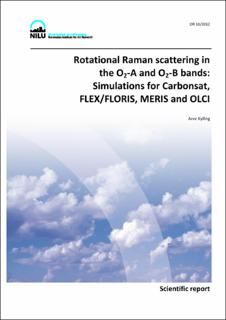Rotational Raman scattering in the O2-A and O2-B bands: simulations for Carbonsat, FLEX/FLORIS, MERIS and OLCI.
| dc.contributor.author | Kylling, Arve | |
| dc.date.accessioned | 2020-12-11T13:16:47Z | |
| dc.date.available | 2020-12-11T13:16:47Z | |
| dc.date.issued | 2012 | |
| dc.identifier.isbn | 978-82-425-2487-4 | |
| dc.identifier.issn | 0807-7207 | |
| dc.identifier.uri | https://hdl.handle.net/11250/2718812 | |
| dc.description.abstract | Rotational Raman scattering (RRS) causes filling-in of absorption lines in Earth shine spectra. It is routinely accounted for in analysis of UV and visible spectra measured both by satellite and ground-based instruments. RRS is also present at longer wavelengths, however, the magnitude generally decreases with increasing wavelength due to decrease in the scattering cross section. For high-resolution spectral measurements the effect may be noticeable. Depending on the application, RRS thus needs to be quantified and possibly corrected for. Of special interest is the effect of RRS in the O2-A (759-769 nm) and O2-B (686-697 nm) bands. Here, the effect of RRS in these bands is studied for the present and future satellite instruments CarbonSat, FLEX/FLORIS, MERIS and OLCI. | |
| dc.language.iso | eng | |
| dc.publisher | NILU | |
| dc.relation.ispartof | NILU OR | |
| dc.relation.ispartofseries | NILU OR;10/2012 | |
| dc.subject | Radiative transfer | |
| dc.subject | Atmosfære og klima | |
| dc.subject | Fjernmåling | |
| dc.subject | Remote sensing | |
| dc.subject | Atmosphere and climate | |
| dc.title | Rotational Raman scattering in the O2-A and O2-B bands: simulations for Carbonsat, FLEX/FLORIS, MERIS and OLCI. | |
| dc.type | Research report | |
| dc.rights.holder | © NILU | |
| dc.source.issue | 10/2012 | |
| dc.relation.project | NILU:111081 |
Tilhørende fil(er)
Denne innførselen finnes i følgende samling(er)
-
NILU oppdragsrapport (1970-2015) [1724]
Rapporter i den avsluttede serien NILU oppdragsrapport (NILU OR).
